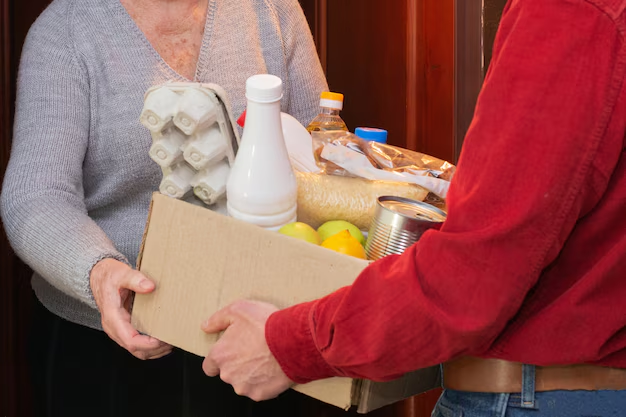Navigating Assistance: A Complete Guide to Disaster Supplemental Nutrition Assistance Program (D-SNAP)
When disaster strikes, basic needs such as food and shelter become urgent priorities. The Disaster Supplemental Nutrition Assistance Program (D-SNAP) emerges as a critical resource, designed to provide immediate food assistance to those affected. Understanding how D-SNAP works can be pivotal for individuals and families in crisis. This guide will demystify D-SNAP, offering insight into its purpose, benefits, and how to access it in times of need.
🌟 The Core of D-SNAP: What You Need to Know
D-SNAP is a program under the broader umbrella of Supplemental Nutrition Assistance Program (SNAP), specifically activated during federally declared disasters. It provides short-term food assistance to individuals who wouldn't ordinarily qualify for SNAP, but who have experienced significant loss due to a disaster.
Key Features of D-SNAP
- Eligibility: Unlike regular SNAP, D-SNAP considers the disaster’s impact on your family’s income and expenses, making it more accessible.
- Process: Eligible recipients receive an Electronic Benefits Transfer (EBT) card, much like the SNAP card, to purchase groceries in authorized retail stores.
- Duration: Benefits last up to a month but can be extended if the disaster impact persists.
📜 Understanding Eligibility Criteria
Eligibility for D-SNAP isn’t merely about current incomes but rather how the disaster has altered your financial situation. Here's how it works:
Who Qualifies?
- Disaster Impact: You must reside or have a job in the disaster area. Significant damage to your home, loss of income, or disaster-related expenses may qualify you for assistance.
- Income Adjustments: D-SNAP calculates eligibility based on your household’s income after considering disaster-related expenses. This flexible approach considers lost income, emergency repairs, and replacement of necessary items.
- Household Composition: Consideration extends to the number of people remaining in the household post-disaster, which impacts benefit amounts.
🛠️ Application Process: A Step-by-Step Guide
Getting access to D-SNAP is structured but straightforward, aiming to deliver aid rapidly to those in need. Here’s a concise breakdown of the application process:
Step 1: Locate a D-SNAP Agency
Following a federal disaster declaration, D-SNAP will be activated, and local departments will announce application sites and timelines. These locations can include:
- City offices
- Disaster recovery centers
- Designated community organizations
Step 2: Documentation Preparation
While the documentation requirements might be less stringent than SNAP's, having the following ready can expedite the process:
- Identification (e.g., driver’s license, state ID)
- Proof of residence in the disaster area
- Details of disaster-related expenses and losses
Step 3: Application Submission
Visit a local site during the established period to fill out the application. Assistance in multiple languages is typically available to ensure accessibility.
Step 4: Receive Benefits
After successful application approval:
- Receive an EBT card for purchasing eligible food items.
- Benefits are often accessible within 72 hours for quick relief.
🤔 Common Questions About D-SNAP
Can I Use D-SNAP Outside My State?
Yes, once your benefits are approved and loaded onto your EBT card, you can use it at any authorized retail location across the country.
Do I Need to Reapply If I Already Get SNAP Benefits?
If you're active in SNAP, disaster-specific adjustments might increase your benefits automatically, but it's advisable to check with local authorities for precise actions required in your case.
🔍 Exploring Related Assistance Programs
During disasters, several other federal and state assistance programs may operate alongside D-SNAP, ensuring comprehensive support. Here's a look at important programs to consider:
FEMA Assistance
Federal Emergency Management Agency (FEMA) provides critical services beyond food, like temporary shelter, home repairs, and other essential personal needs.
Cash Assistance Programs
Programs targeted at providing immediate cash support to cover essentials during a disaster can be an additional resource for affected families.
📊 Handy Checklist: Preparing for D-SNAP
Getting ready for possible eligibility can streamline your application process. Here's a quick checklist with essential steps to prepare for D-SNAP:
- 📍 Stay Informed: Follow local news or community bulletins for notices about D-SNAP activation.
- 📝 Compile Documentation: Ensure proof of identity, residence, and disaster impact is accessible.
- 🗓️ Keep Track of Expenses: Maintain a record of disaster-related costs to support your application.
- 📞 Contact Local Authorities: Verify any questions or concerns about eligibility and benefits.
🏆 Real-Life Impacts: Stories of D-SNAP
A brief exploration into its effectiveness reveals how D-SNAP has been a beacon of hope for countless families. After Hurricane Katrina, for instance, many residents gained access to meals they couldn’t afford due to sudden unemployment or loss of shelter. This level of relief allows families to focus on recovery and rebuilding without the immediate stress of food insecurity.
🕒 Where Do We Go From Here?
Understanding D-SNAP and how it fits into the broader response to emergencies is crucial for maximizing its benefits. Recognizing the interconnectedness of various support programs ensures comprehensive assistance during dire times. By preparing ahead, you can smooth the process of accessing D-SNAP and allied services, turning a potentially tumultuous experience into a more manageable situation.
As we continue to face climate variability and other challenges, having a foundational understanding of programs like D-SNAP is no longer optional—it is a necessity. Being proactive equips individuals with the power to take necessary steps toward sustenance during uncertain times. This guide aims to not just inform, but to empower individuals and communities with a means to bounce back efficiently from adversity.

Related Topics
- A Comprehensive Guide To Crime Victim Assistance
- A Comprehensive Guide To Economic Infrastructure Development
- A Comprehensive Guide To Low-Income Housing Repair Loans And Grants
- A Comprehensive Guide To The Emergency Solutions Grants Program
- A Comprehensive Guide To The Senior Companion Program
- A Comprehensive Guide To The State Childrens Health Insurance Program
- A Comprehensive Guide To The TANF Program For Needy Families
- Additional Child Tax Credit
- Adoption Assistance
- Adult Basic Education Grants